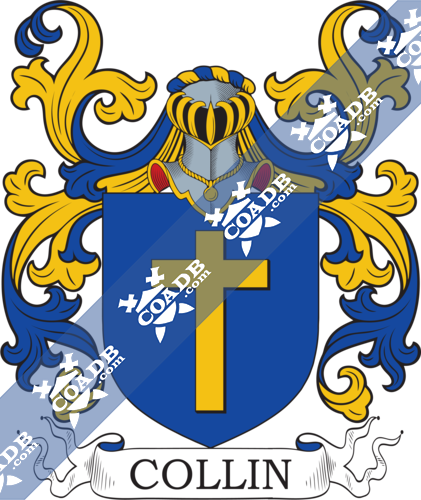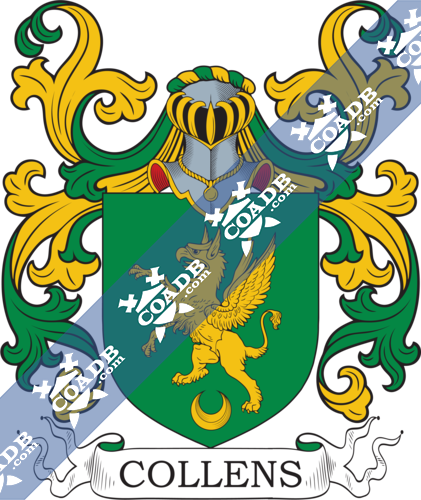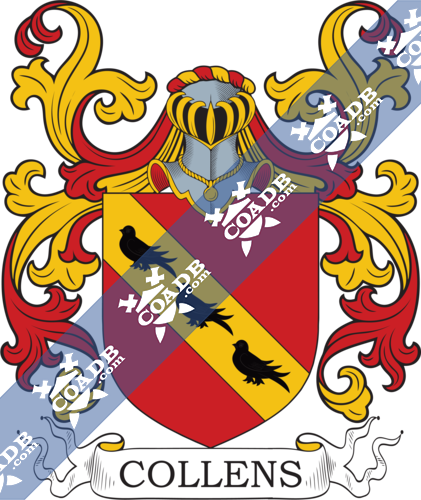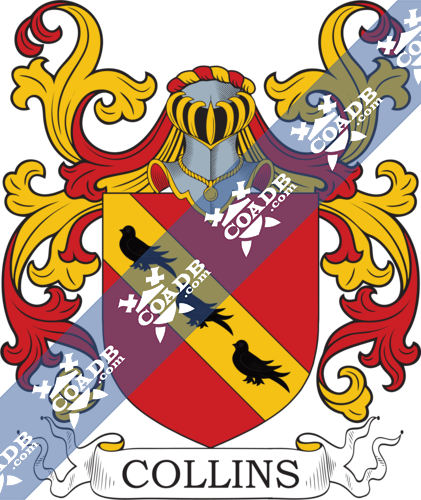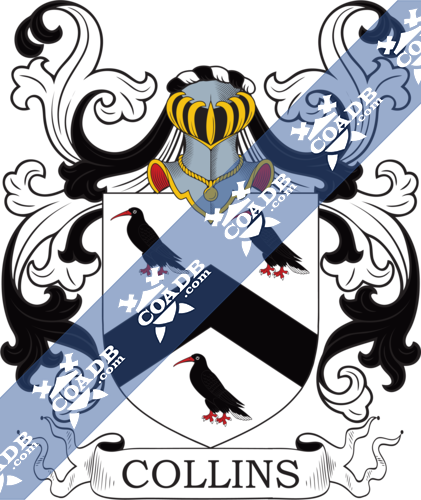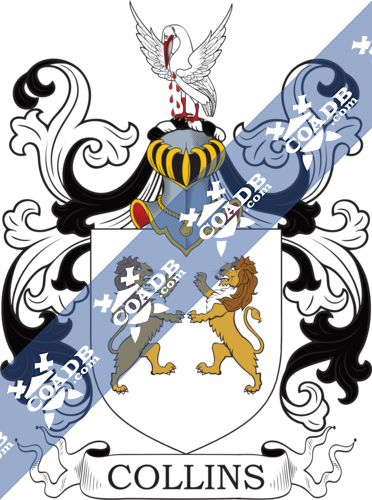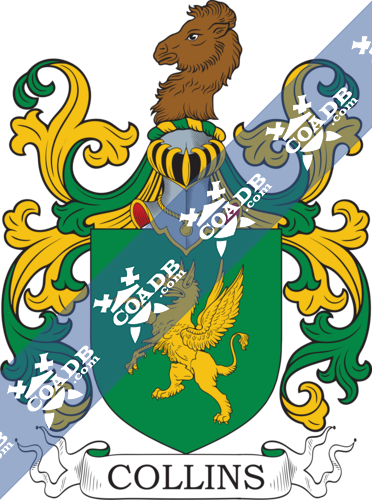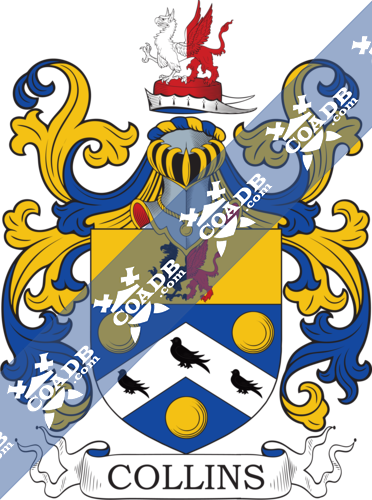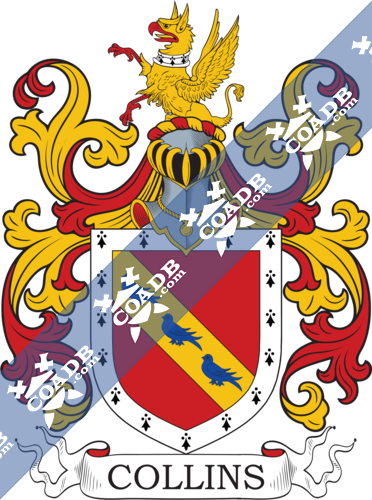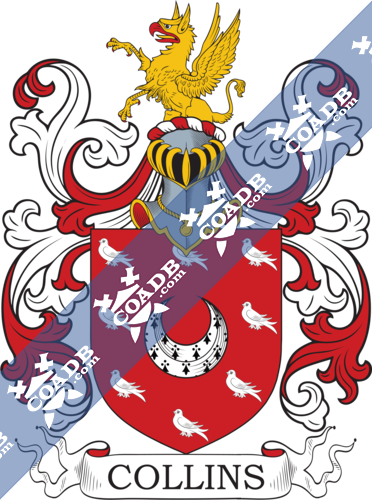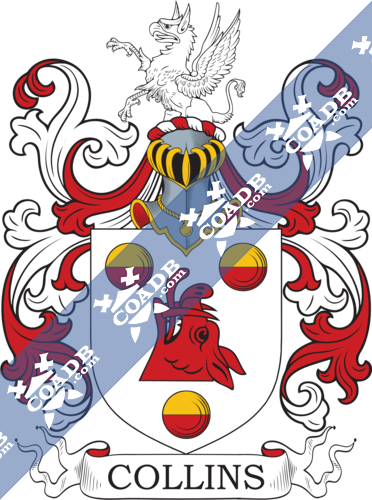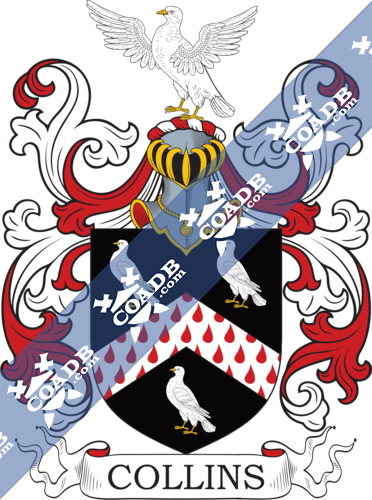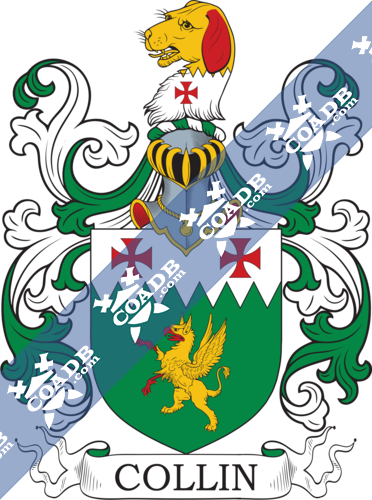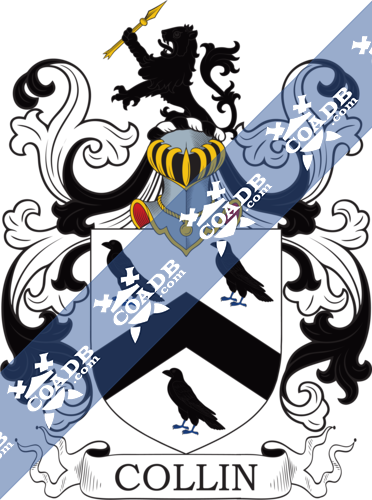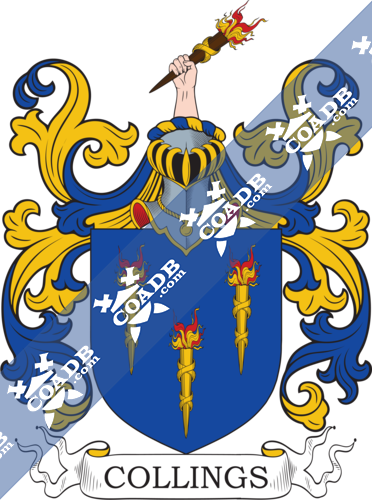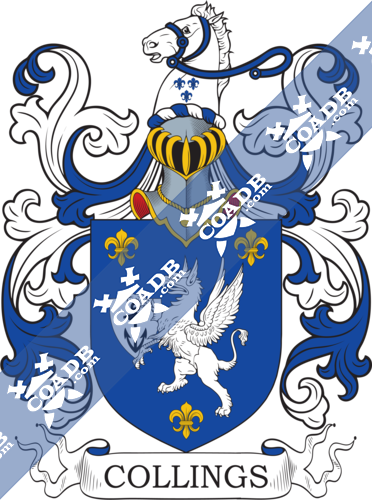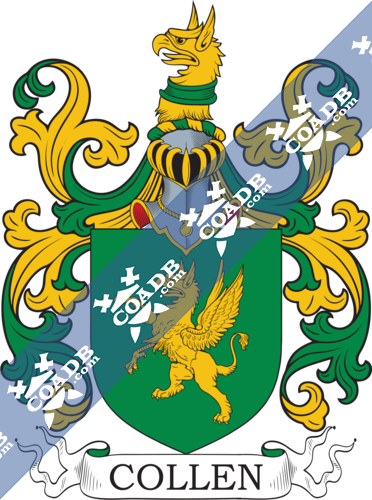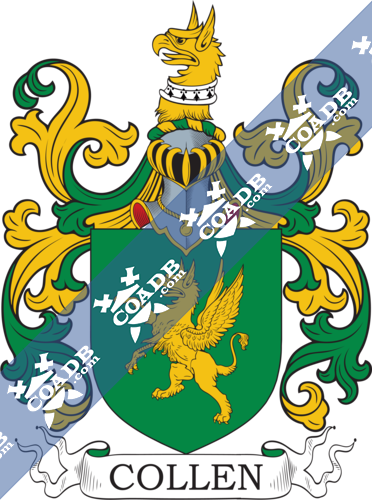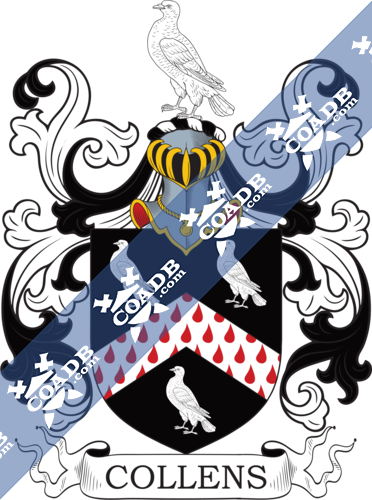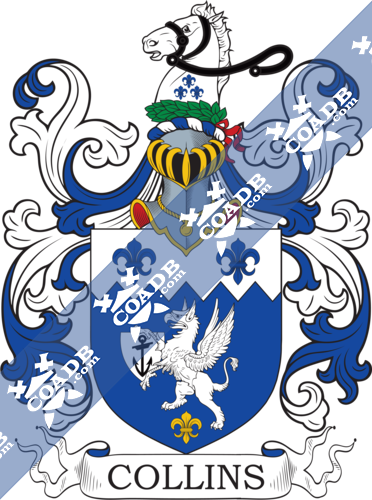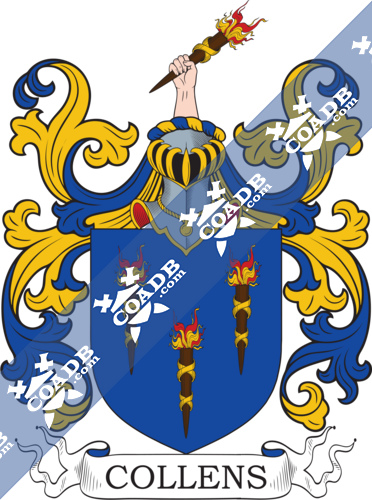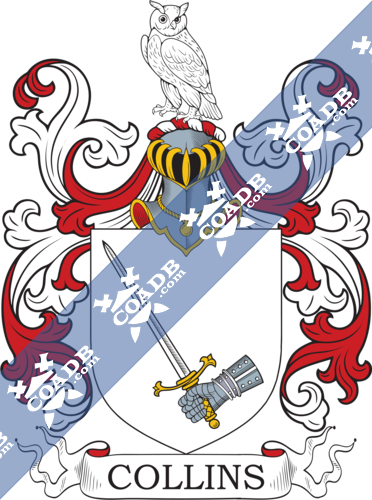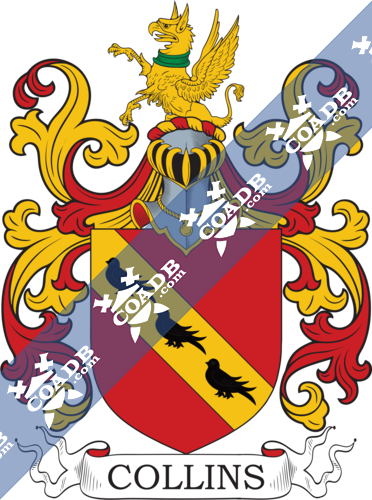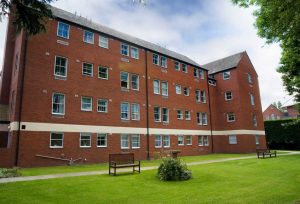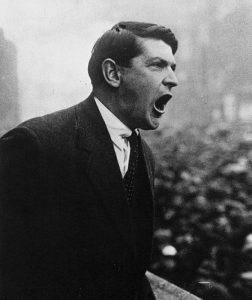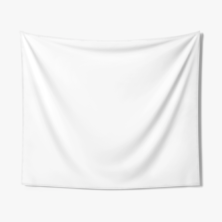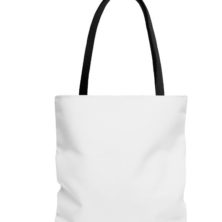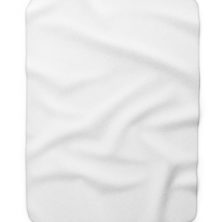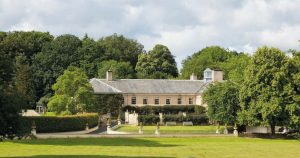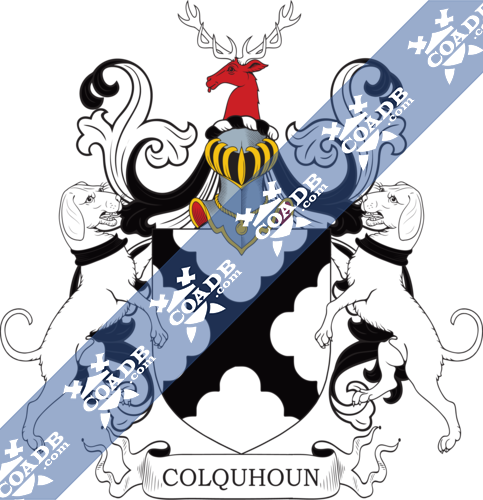Collins Family Crest, Coat of Arms and Name History
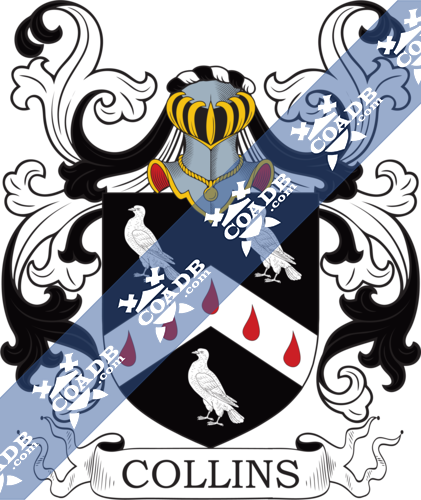
Collins Coat of Arms Gallery
Don’t know which Coat of Arms is yours?
We can do a genealogical research. Find out the exact history of your family!
Learn MoreSurname Name Meaning, Origin, and Etymology
This has four origin theories. First, it likely a baptismal surname meaning “the son of Nicholas” from the nickname Coll or Cole, and hence it can also mean “the son of Col”. Nicholas is an ancient Greek/Roman personal (first) name. The letter g in Collings is excrescent (added without etymological justification). Second, it can be an Anglicized form of the Gaelic surname O’Coileain or MacCoileain (related to Cullen). The word cuilein meaning darling, a term of endearment applied to a young animal (particularly a dog). Third, it can be an Americanized spelling of the French last name Colin. Fouth, it may derive from the Welsh word collen, meaning hazel or hazel grove. The name was first established in North Desmond the ancient Kingdom of Deis Muin where the family was lords of the barony of Conello and Eighter Conghalach. In the 1200s AD, they branched out into West Cork, having been driven out from their lands by the Geraldine family. In England, they were first found in Shropshire.
The book “A genealogical history of Irish families” states the family is descended from Milesius, King of Spain, through his son Heber. This claim is dubious given said king is considered to be mythical by most historians, and the author of the book makes this same claim in regard to many other Irish surnames. The book claims the Collins family was founded by Cormac, King of Munster, who lived in the 5th century AD. The tribe’s chief was McCarthy More, Prince of Muskerry, King and Prince of Desmond, King of Cashel and Munster. The ancient spelling was Cullen, meaning “fair haired”. The author states “Many of this name occupy an honorable place in Irish annals. John O’Cullane, or Collins, was one of the most meritorious of the Irish poets of the last century. Many of his productions have been admirably rendered into English by Sir Samuel Ferguson and others. There have been many distinguished members of this family in the United States, notably the late Jerome J. Collins, the meteorologist and discoverer of the law of storms. It was he who invented and perfected the system of predicting the meteorological changes, by which storms can be accurately foreshadowed and located, and people forewarned of the approaching danger. Mr. Collins lost his life a few years ago in the unfortunate Jeanette polar expedition. Another conspicuous member of the name is General P. A. Collins, the present United States consul-general in London, England, and formerly member of Congress from Boston, Mass. As an orator and lawyer, General Collins enjoys a national reputation. The late William Collins, poet and journalist, of New York, was also a descendant of the Munster Collinses, although born in the County of Tyrone”.
Spelling Variations
Common spelling variants or names with similar etymologies include Collings, O’Collins, Collen, Collens, Collinson, Colling, Collyns, and Collinge. There are other foreign names that sound or are spelled similar: Kollr/Kolr (Norse), Kull (Swedish), Koelle (Danish), Kolla/Koller/Kolley/Kohl/Kohler (German), Koll (Dutch), Colas/Colle/Colles/Cules (Flemish). The Domesday Book of 1086 AD , a survey of England and Wales ordered by William the Conqueror, lists Col, Cola, Colo, and Cols. The name Colin is also found in Scotland and Gaelic etymologists derive it from the word cailean or coilean, meaning “man of the wood”, a forester.
Popularity & Geographic Distribution
The last name ranks Collins ranks 52nd in popularity in terms in the United Status as of the 2000 Census. The name ranks particularly high in the following six states: Massachusetts, Delaware, and New Hampshire. The surname is even more common in England, where it ranks 55th. It ranks highest in the following counties: Sussex, Kent, Surrey, Hampshire, and Berkshire. The name is common throughout the English speaking world: Scotland (135th), Wales (55th), Ireland (36th), Canada (118th), New Zealand (76th), Australia (49th), and South Africa (374th).
The 1890 book Homes of Family Names by H.B. Guppy, states the following in regard to this surname: “Probably a diminutive of Cole, and like it a south of England name, being most frequent in the adjacent counties of Kent and Sussex. In the north of England its place is taken by Collinson”.
Early Bearers of the Surname
The earliest known bearer of this surname was John Collin who was documented in the King Rolls of Devonshire in 1221 AD. The Hundred Rolls of 1273 AD, a census of Wales and England, known in Latin as Rotuli Hundredorum lists three bearers of this surname: William filius Colini in county York, Alan Colin in county Norfolk, and John filius Colini in county Suffolk. The Poll Tax of Yorkshire in 1379 AD lists two bearers of this last name: Johannes Colinson and Johannes Colynson. John Colyngs was listed in county Somerset in Kirby’s Quest during the reign of King Edward III of England. Early marriages including this surname include Katherine Collyn to William Inman in London in 1585, and Mabella Collins to Jacob Marsh at St. Michael, Cornhill in Lodnno in 1682.
History, Genealogy, and Ancestry
Edward Collins was born in Donegal, Ireland in around 1277 AD. He married Katherine Gallagher. They had a son named John. John was born around 1297 and he was married Rebecca (last name unknown) and had a son with her named Aaron. Aaron was born in 1318 AD and he married Ann, with whom he had a son named Andrew. Andrew was born in 1338 and he married Mary and had the following children with her: David, Aaron, Elizabeth, Isabel, and Eleanor.
The famous genealogist Bernard Burke’s book “The Landed Gentry” discusses eight branches of this family: 1) Collins of Walford, 2) Collins of Betterton, 3) Collins of Truthan, 4) Collins-Trelawny of Ham, 5) and Collins of Knaresborough.
The first branch discussed is Collins of Walford. It begins with a mention of John Stratford Collins, Esquire of Walford in county Hereford, an officer in the 2nd Queen’s Royal regiment, who was born in 1851. Burke states this family is of great antiquity in counties Hereford and Salop. William Collins, Esquire of Upton in county Hereford was a Captain in the Trained Bands. In 1680, he married Mary, daughter and heiress of Robert Stratford, Esq. of Walford. His son and heir was James Collins, Esq. who in 1726, married Elianor, daughter of John Stacy, Esq. of London. He had a son and heir named John Stratford Collins. John was born in 1730 and was High Sheriff in county Hereford in 1774. In 1758, he married Alice, daughter of John Furney of Perristone, and died, leaving children: John, Ferdinando (served in Royal Navy), and Alicia (married Reverend John Howton Beeston). His elder son John Stratford Collins, Esq. of Walford, who married Mary, daughter of James Davies. They had the following children together: John Stratford, Ferdinando Stratford (married Frances Morris) and, James (married Eliza Gwillim). He died in 1809 and was succeeded by his son, John Stratford Collins, Esq. of Walford. He married Edith, daughter of Philip Jones, and had seven children with her: John Stratford, William Hutcheson (of Cubberley House, Officer of the county Hereford Militia), Nathaniel Kyrle (of Wiltondale, captain of 2nd Herefordshire Rifle Volunteers), Edith Alicia, Sarah, Anne Jones, and Katherine. He died in 1859 and was succeeded by his eldest son: John Stratford Collins, Esq. of Walford in county Hereford. In 1848, he married Ellen, daughter of John Lloyd, and had three issue with her” John Stratford of Wythall, Amy Stratford, and Ellen Edith Lloyd (married Wright Sherlock). He graduated from Cambridge and was Justice of the Peace and Deputy Lieutenant. He died in 1877. The Collins family crest has the following blazon in heraldry: Vert, a griffin sergeant and a crescent or.
The second is Collins of Betterton. It begins with a mention of The Reverend John Ferdinando of Betterton, Berks, Justice of the Peace who was born in 1812. In 1836, he married Sarah, daughter of John Hawthorn, Esq. of Glenluce, county Wigton, and late of Jamaica. He had the following issue with her: Reverend John Ferdinando (1837), Henry (1838), Charles (1839), Robert Hawthorn (1841), Arthur (1845), Francis (1851), Emily Jane, and Fanny Katherine. Burke traces the lineage back to Charles Collins, of Pembroke College Oxford, and the Middle Temple, born 1666, lineally descended from Thomas Collins of Betterton who lived during the time of King Henry VI. Charles married Anne, daughter of John Head of Hodcut and had two daughters with her: Charlotte (married John Saunders of Woolston) and Frances (wife of Richard Hartend). He later married Elizabeth Coghill of Bletchington and later Anne, daughter of Ferdinando White, and had a son with the later named Ferdinando Collins. Ferdinando Collins, Esquire married Katherine Boote of Deuciss and had issue with her. His son and successor was Reverend John Collins born in 1753. He was Vicar of Cheshunt born in 1753. He married Martha, daughter of James Smith, Esq. of Rotterdam and Hammersmith, and had John Ferdinando, Katerine (married Reverend Giles Daubency), Anna Maria (married Reverend Benjamin Morland). The Collins coat of arms is vert, a griffin passant or, a chief ermine.
The third branch mentioned is Collins of Truthan. It begins with a mention of Digby Collins, Esq. of Truthan and Newton Ferrers, Cornwall who was born in 1836 and succeeded his brother in 1870. Burke states the family of Collins is of very ancient standing in Cornwall. John Collins represented Launceston Parliament and in the 11th and 15th Richard II was Sheriff of the county The great-grandfather of the present proprictor of Truthan was John Collins, Esq. of Treworgan, High Sheriff of Cornwall. In 1726, he married Mary May, and had two sons with her: Edward and John. His son Reverend John Collins married Mary Francis Bassett of Tehidy Park, with whom he had a son named John. He later married Constance, daughter of Paul Mitchell, and had a son with her named Edward. He later married Anne Williams, with whom he had Charles, Reverend Jeremiah, and Anne. Edward Collins, Esq. of Truthan, Cornwall was born in April of 1747 and he was High Sheriff of Cornwall in 1801. In 1779, he married Mary, daughter of Reverend Richard Thomas, and he had issue with her He died in 1827 and was succeeded by his eldest son Edward. Edward Collins was an Esquire, Justice of the Peace, Deputy Lieutenant, of Truthan, and Newton-Ferrers, Dornwall, and High Sheriff in 1830. He was born in 1782 and in 183, he married Elizabeth, daughter of Francis Drake, and had two issue with her: Edward, Charles (born 1835 and married Alethea, daughter of Rev. Robert Gee), and Digby. His eldest son was Edward Collins, Esquire, Justice of the Peace, and Deputy Lieutenant for Truthan and Newton Ferrers. He was born in 1833 and was succeeded by his brother, Digby. The Collins Family crest is Sable a chevron argent guttee-de-sang between three doves proper.
The fourth branch mentioned is Collins-Trelawny of Ham. It begins with a mention of Reverend Charles Trelawny, M.A. of Ham, Devon, and former Fellow of Balliol College, Oxofrd, and Rector of Timsbury. He was born in 1792 and in 1831 he married Elizabeth Ayliffe, daughter of Edward and Marianne Boodle of London). He assumed the surname Trelawny in 1839 upon the death of his mother. Burke traces the lineage to Arthur Collins, a famous genealogist and antiquary, who was born in 1682, and was son of William Collins of the Inner Temple.
The fifth and final branched discussed is Collins of Knaresborough. It begins with a mention of Thomas Collins, Esquire of Knaresborough and Follyfoote in county York who was born in 1825. He was Barrister-at-Law, Justice of the Peace, and Deputy Lieutenant for the West Riding. He was also a member of Parliament for Knaresborough and Boston. He succeeded his father in 1870. Burke states the family has the same arms as the ancient family of the same name of Brightling and Burwash, Sussex. Thomas Collins of York married Mary Knaresburgh and had five children with her: Richard (1665), Thomas (1668), James, Mary (1666), and Ann (1669). He died in 1707 and was succeeded by his youngest son James. James was born in 1673 and was of Knaresborough and Ferenzbie. He married Mary Green and had issue with her: Reverend Thomas (a scholar born in 1707 who married Mary Woodburne), Henry (born 1714), James, Francis, William, Richard (of Leeds), Jane (married Richard Cundall), Mary (married John Beckwith), Ann, Margaret, and Ann. His second son was James Collins, Esq. of Knaresborough and Follyfoote who was born in 1712. In 1733, he married Elizabeth Richardson, and had seven children with her: Thomas (1734), Lasscells (1737), James, Sarah, Mary (married Reverend Thomas Lamplugh), Elizabeth (1741), and Ann. His youngest son, also named James, was born in 1744 and in 1776, he married Katherine West. They had four sons together: James Richardson, Thomas, William, and William. The pedigree, genealogy, and ancestry of the Collins family goes on for another page in the book. The Collins coat of arms was blazoned as follows in heraldry: Gules, on a bend or, three martlets azure, the whole within a bordure ermine.
Edward Collins was born in Penkridge, Staffordshire in England in 1563. He married Mary Anson and had a daughter with her named Katharine. He died in 1655 in the same town.
James T. Collins was born in 1831 in Ireland and he came to Buffalo, Erie, New York, in the United States. He married Anna Madden and had six children with her: John J., Mary E., Wiliam J., Ellen T., and Thomas James.
John Collins was born between 1528 and 1554. He married Abigail Rose and had the following children with her: Katherine, Daniel, Edward, John, Martha, Elizabeth, Sybil, Joan, Mary, and Rev. Samuel. His son Daniel was born in 1583 in Suffolk, England. He married Sybil Franklyn and had the following issue with her: John, Rebecca, Elizabeth, Edward, John, Martha, Elizabeth, and other.
Early American and New World Settlers
The book Genealogical Guide to the Early Settlers, mentions 21 people bearing this surname:
1) Anthony Collins of New Hampshire who was of the Grand Jury in 1684 whose widow died in 1700
2) Benjamin Collins of Salisbury who married Martha, daughter of John Eaton, in 1668 and had issue with her: Mary (1670), John (1673), Samuel (1676), Ann (1679), Benjamin (1681), and Ephraim (1683).
3) Benjamin Collins of Lynn, freeman 1691, who married Priscilla Kirtland in 1673 and had issue with her: Susanna (1674), William (1676), and he later married Elizabeth Putnam and had issue with her named Priscilla (1679), Elizabeth (1682), and Benjamin (1684).
4) Bernard Collins of New London who drowned in 1660
5) Christopher Collins of Boston who in 1640 had a grant at Braintree. It was suspected he was murdered by his neighbor, but the neighbor was acquitted by a jury. His widow was named Jane and he left her 422 pounds of sterling, 14 schilling, and 23 cows.
6) Daniel Collins of Enfield in 1683 who died in 1690 at the age of 9.
7) Ebenezer Collins of New Haven, who married Ann (in about 1683), the widow of John Trowbridge and the daughter of Governor William Leete (Governor of the Colony of New Haven), and had a son with her named Mehitable.
8) Edward Collins of Cambridge, 1638, who was a freeman in 1640 and a deacon representative in 1654-1670. He lived on the plantation of Governor Cradock and purchased it.
9) Elizur Collins of Warwick in 1644
10) Francis Collins of Salem in 1637, who had a daughter named Hannah who married John Brown of Salem
11) Henry Collins of Lynn who came aboard the Abigail in 1635 at the age of 29 with his wife Ann and children John and Margery, as well as servants. He also had sons named Henry and Joseph.
12) Hugh Collins of Norwich or Lyme
13) James Collins of Salem who was a shipmaster who was lost at sea in 1685
14) John Collins of Gloucester, may have had grant of land at Salen in 1643. His wife was Joan. He had children John (born in England likely), James (1643), and Mary (1646).
15) John Collins of Boston, the brother of Edward, was a member of an artillery company in 1644. He married Susanna and had children John, Thomas, Susannna (married Thomas Walker), and Elizabeth.
16) John Collins of New London in 1680 or 1683
17) Joseph Collins of Eastham who married Duty Knowles in 1676 and had children with her: Sarah (1673), John (1674), Lydia (1676), Joseph, June (1678), Hannah (1680), Jonathan (1682), Jane (1684), Benjamin (1687), and James (1689)
18) Peter Collins of New London win 1650
19) Peter Collins of Pemaquid in 1674 who swore fidelity to Massachusetts
20) Samuel Collins of New London in 1680 he married Rebecca, widow of Joseph Hunt, in 1695.
21) Thomas Collins of Boston in 1677 who was a merchant.
A one Walter Collins went to St. Christopher’s aboard the Mathew of London in May of 1635. A one William Collins came to Virginia aboard the Plaine Joan in May of 1635 from the port of London. A one Giles Collins, aged 20 years, came to Virginia aboard the Paule in July 1635. A one David Collins was recorded among the dead in Virginia in 1623, as was one Josias Collins (in Warwicke Squeak). A one Nicholas Collins Jr. was listed as prisoner from Monhmouth’s Rebellion of 1685 who was transported from Taunton.
Other early settlers in colonial America bearing this surname include Susan Collins (1613 Virginia) and Peeler Collins (1621 Virginia).
Clarence Lyman Collins was born in Hartford, Connecticut in 1848. He married Marie Louise Clark, daughter of Horace F. Clark, and had a daughter with her named Edith Lyman (who married Richard Bey, Count Czaykowski). He bore the following Collins coat of arms or Collins family crest: Sable, on a chevron between three doves argent, five guttees de sang. He was the son of Charles, and he descended from John Collins (1616-1670) of Boston.
Edward Collins, a merchant and gentlemen of Cambridge, MA in 1636 bore the following arms, Argent, a dexter hand gauntleted in sinister base grasping a sword in bend proper, pommel and hilt or. Crest: An owl argent.
One of the earliest settlers in Australia with this surname was Dennis Collins, who came aboard the Ann in 1809 and settled in New South Wales. He was a convict from Kent. In New Zealand, one of the earliest settlers was
Mottoes
We have identified eight Collins family mottoes:
Per callem collem (By the path the hill) (Collins of Betterton)
Fide et virtute (By valour and faith)
Colens Deum et regum (Honouring God and the King)
Favente Deo et sedulitate (God and assiduity favouring)
Sermoni consona facta (Deeds agreeing with words) (in county Devon)
Frangas non flectes (Thou may’st break, but shalt not bend me)
Volabo ut requiescam (I will fly away to be at rest) (Collens or Collins of Dorset, Psalms IV 6)
Fidelis in omnibus (Fidelis in omnibus)
Grantees
We have 32 coats of arms for the Collins surname depicted here. These 31 blazons are from Bernard Burke’s book The General Armory of England, Ireland, and Scotland, which was published in 1848. The bottom of this page contains the blazons, and in many instances contains some historical, geographical, and genealogical about where coat of arms was found and who bore it. People with this last name that bore a Collins Coat of Arms include:
1) Henry Collins of Budes or Budby in Kent, 10 May 1576
2) John Collins of Betterton in Berkshire, 6 May 1672, by Sir E. Bysshe
3) Joshua Collin of London, of Lincoln’s Inn, 21 January 1639-40
4) Richard Collins of Upton, county Hereford, s. of Henry, one of the ushers of Her/His Majesties Chambers, descended from Collins of Shropshire, confirmed October 1612 by Camden
5) Thomas Collins of Collyns, prior of Tywardreth, Cornwall, 16 March 1522, by Writhe
6) Thomas Collins of Brightling, Sussex, by Segar, 1633 (?), 1562 (?)
7) William Collins of Rotterdam, Holland, Burke’s Armory
Notables
There are thousands of notable people with the Collins surname. This page will mention a handful. Famous people with this last name include: 1) An Collins who was a 17th century English poet, 2) John Collins (1776-1822) who was the 22nd Governor of Delaware, 3) Thomas LeRoy Collins (1909-1991) who was the 33rd Governor of Florida, 4) Thomas Collins (1732-1789) who was an lawyer that became the Governor of Delawre, 5) Suzanne Collins (1962) who is an American author known for writing the popular The Hunger Games trilogy, 6) William Edward Collins (1867-1911) who was Bishop of Gibraltar, 7) Shirley Elizabeth Collins (1935) who was an English folk singer from Hastings, Sussex, and 7) Susan Margaret Collins (1852) who is a Republican Senator from Maine.
Blazons & Genealogy Notes
1) O’Collins (the Sept of O’Coilen, of the same race as O’Donovan: they inhabited the district of Ну Conaill, co. Limerick, but were driven out of their country by the Geraldines). Ar. two lions ramp. combatant ppr. Crest—A pelican vulning herself, wings elevated all ppr.
2) (Betterton, co. Berks). Vert, a griffin pass, or, a chief erm. Crest—A griffin’s head erased vert, crowned or. Motto—Per callem collem.
3) (granted to William Collins, of Rotterdam, Holland). Az. a griffin segreant holding betw. the claws an escutcheon ar. the latter charged with an anchor erect sa. in base a fleur-de-lis or, a chief dancettee of the second, thereon two fleurs-de-lis of the field. Crest—A horse’s head couped ar. bridled sa. charged on the neck with three fleurs-de-lis, one and two, az. and gorged with a wreath of laurel vert.
4) (Wythall Walford, co. Hereford, as borne by John Stratford Collins, Esq., J.P. and D.L., (of an ancient Saxon family) great grandson of John Stratford Collins, Esq., High Sheriff co. Hereford, 1773, who was grandson of Captain William Collins, of Upton, by Mary, dau. and eventual heiress of Robert Stratford, Esq., of Wythall). (Cubbuley House, co. Hereford). (Wiltondale, Bridstow, co. Hereford). (Drybridge House, Hereford, and Brange Court, co. Hereford). (Upton, co. Hereford, confirmed by Camden, Oct. 1612). Vert, a griffin segreant and a crescent or, with numerous quarterings, including Loudam, Eaton, Stoke, Stewmarch, Langley, Hereford, Cresswell, Sturney, Downman, Collins, Stratford, Furney, Abrahall, &c., &c. Crests—1st: A demi griffin or, collared erm.; 2nd: A dexter arm embowed habited ar. the hand ppr. holding a scimetar or. Mottoes —Fide et virtute; and Colens Deum.
5) (Samuel Collins, M.D., Fellow of Trin. Coll., Cambridge, descended from the ancient families of Collins, of Devon and Somerset, who m. 1st, Ann, dau. of John Bodenham, Esq., and 2nd, Katherine, Dowager Countess of Carnwath). Gu. on a bend or, three martlets sa.
6) (Richard Collins, Esq., of Corely, co. Salop, principal secretary to Henry, Earl of St. Albans, Lord High Chamberlain). Vert, a griffin segreant or.
7) Or, a griffin segreant sa. Crest—A demi griffin segreant or, collared with a bar gemelle gu. Motto—Favente Deo et sedulitate.
8) (Foye, co. Hereford. Settled there in the 15th century. William Collins was member of the Parliament of the 36th, 39th, 43rd, 45th and 49th of King Edward III. for the city of Hereford. James Collins, of Foye, gent., who m. 1673, Mary, dau. and eventually co-heir of John Abrahall, Esq., of Ingestone, co. Hereford, borne for arms). Gu. on a bend or, three martlets sa. Crest—A demi griffin or, collared vert.
9) or Collyn – (Cornwall). Ar. a chev. sa. betw. three Cornish choughs ppr.
10) (Ham, co. Devon; of an ancient Kentish family. George Collins, Esq., m. the dau. and heiress of Samuel Pollexfen Trelawny, Esq., of Ham, who d. in 1771, and thus acquired the estate of Ham). Vert a griffin segreant or. Crest—A camel’s head erased ppr. Motto—Sermoni consona facta.
11) (co. Devon). Sa. on a chev. betw. three doves ar. five guttes de sang.
12) (Essex). Az. on a chev. ar. betw. three bezants, as many martlets sa. on a chief or, a griffin pass, with wings endorsed per pale sa. and gu. Crest—On a chapeau gu. turned up erm. a griffin pass. per pale ar. and gu.
13) (Kent; granted 12 May, 1570). Vert, a griffin segreant or, beaked, legged, and ducally gorged ar. Crest—A demi griffin or, beaked, legged, and ducally gorged ar.
14) (Sittingbourn, co. Kent, London and Sussex). Gu. on bend or, three martlets az. all within a bordure erm. Crest—A demi griffin or, beaked and legged gu. collared erm.
15) (Hatch Beaumont, co. Somerset). Gu. a crescent erm. within an orle of martlets ar. Crest—A demi griffin or, armed gu. Motto—Frangas non flectes.
16) Ar. a boar’s head couped and erect gu. betw. three roundles per fesse or and gu. Crest—A demi griffin ar.
17) Gu. on a bend or, three mullets of the field (another, three martlets sa.).
18) (Truthan, co. Cornwall). Sa. a chev. ar. guttee-de-sang betw. three doves ppr. Crest—A dove with wings expanded ppr. Motto—Volabo ut requiescam.
19) (Trewardale, co. Cornwall, shewn on an old monument, dated 1684, in the parish of Illoggan, of which place the ancestors of the present Rev. Charles Mathew Edward Collins were incumbents in succession frum 1533 to 1684). Same Arms, Crest and Motto. Some authorities, and amongst others, Halse, the Cornish historian, and the present Sir John Maclean, a very learned writer on Cornish history, consider that the birds in the arms should be described as Cornish choughs and not as doves, the motto being understood to apply to the crest, which is undoubtedly “a dove rising ppr.”
20) (Elton, co. Nottingham). Vert, a griffin segreant or, beaked and membered gu. on a chief indented ar. two crosses formee of the third. Crest—A talbot’s head erased per fesse indented or and ar. eared and charged on the neck with a cross formee gu.
21) (Rene Collin, of St. Malo, in France, 1700). Az. a passion cross or.
22) (Collinstown, now Cullenstown, co. Wexford, allowed by Hawkins, Ulster, 1725, to Richard Collin, of co. Wexford, gent., descended from John Collin, of Cornwall, who came to co. Wexford, 1170). (Brisbane, in Brittany, allowed by Hawkins, Ulster, 1768, to Francis William Collin, of that place, descended from Collinstown, co. Wexford). Ar. a chev. betw. three ravens close sa. membered az. Crest—A demi lion sa. holding in the dexter paw a broken lance or.
23) or Collins – Az. on a chev. ar. betw. three bezants as many birds sa., on a chief or, a griffin pass, per pale gu. and sa. Crest—A griffin pass. gu. Another Crest—On a chapeau gu. turned tip erm. a griffin pass. per pale sa. and gu.
24) (St. Mary Ottery and Barnshill, c.o. Devon. Visit. 1620). Az. three torches or, enflamed ppr. Crest—A cubit arm erect the hand holding a torch, all ppr.
25) (Guernsey). Az. betw. three fleurs-de-lis two and one or, a griffin segreant holding betw. the claws an escutcheon ar., the latter charged with an anchor sa. Crest—A horse’s head erased ar. bridled and charged on the neck with three fleurs-de-liz az. two and one. Motto—Fidelis in omnibus.
26) or Collin, or Collings – (High Laver, co. Essex). Vert a griffin segreant or. Crest—A griffin’s head erased or, collared vert.
27) (cos. Essex, Kent, and Stafford, 1612). Same Arms. Crest—A griffin’s head erased or, collared erm. Another Crest—A demi griffin or, collared az.
28) (Little Laver, co. Essex). Same Arms, a crescent for diff. Crest—A griffin’s head erased vert collared erm. and charged with a crescent.
29) or Collins – (Offwell, co. Dorset). Sa. a chev. ar. guttee de sang betw. three doves of the second. Crest—A dove ar. Motto—Volabo ut requiescam.
30) or Collenswell – (Barnes Hill, co. Devon). Az. three firebrands ppr. Crest—A cubit arm holding a firebrand all ppr.
31) (Upton, co. Hereford; confirmed Oct. 1612). Vert a griffin segreant or, a crescent for diff.
32) Gu. on a bend or, three martlets sa.


